Off-Axis Cavity-Enhanced Absorption Spectroscopy of 14NH3 in Air Using a Gain-Switched Frequency Comb at 1.514 μm
Abstract
1. Introduction
2. Experiment
3. Results and Discussion
3.1. Single-Pass Absorption Spectrum of NH3
3.2. Off-Axis Coupling of the GSFC to the Cavity Without Target Species
3.3. GSFC Application to off-axis Cavity-Enhanced Detection of NH3 at 6604–6607 cm−1
3.4. Uncertainties and Stability Considerations
- One of the smallest systematic uncertainties is the measured cavity length which was estimated to be Δd = ±1 mm (≈0.2%).
- Another general systematic error is caused by the dependence of the mirrors’ reflectivity on the shift of the laser beam away from the center of the mirror. The reflectivity at the center of the cavity mirror was measured with an absorption spectrometer to be R = 0.9960 for normal incidence. At an offset from the mirror center of ≈4 mm, the reflectivity was found to be R = 0.9940. Due to the finite diameter of the beam in the reflectivity measurement and also in the CEAS measurements with off-axis alignment (GSFC beam diameter ∼1 mm), the uncertainty ΔR was estimated to be ±5 × 10−4. This uncertainty results in an error of Δ(1−R) ≈ 8.3%, which is relevant for the evaluation of the absorption coefficient. Based on this systematic error alone, absolute gas concentrations are affected, causing an error in the detection limit of approximately ±0.3 ppmv.
- A systematic uncertainty is also caused by the small inherent intensity noise of the GSFC coupling to the cavity in on- and off-axis configuration, which was estimated by recording 50 consecutive transmission spectra (30 s integration time) of the cavity at intervals of 40 s. At each wavenumber in the spectrum, the standard deviation of the 50 measurements was evaluated for on- and off-axis (shift of 4 mm) measurements. The mean 1σ standard deviations,, averaged over all wavenumbers for on- and off-axis configurations were found to be 0.042 (=4.2%) and 0.0014 (=0.14%), respectively. The maximum values of standard deviation, , in on- and off-axis configuration were 0.3331 (=33.3%) at 6604.74 cm −1 and 0.005 (=0.5%) at 6604.78 cm−1, respectively. Assuming the latter maximum deviation as the sole systematic error concerning the intensity (ΔI = 0.5%), an optimal (theoretically achievable) lower limit of the minimum detectable absorption coefficient of 5.4 ×10−7 cm−1 for an integration time of 20 s can be estimated. This corresponds to a detection limit of 830 ppbv, i.e., approximately a factor of 4.5 below the detection limit evaluated from the absorption measurement of NH3 used here to determine the experimental detection limit.
- The absorption cross-sections as well as the air- and self-broadening parameters in the HITRAN database have uncertainties that add to the overall absolute systematic error of the calculated absorption coefficients (and number densities). The five strongest absorption features of NH3 in the region between 6604 and 6607 cm−1 are given in Table S1 (supplementary material), together with the relative uncertainties of the corresponding absorption strengths (ΔS), all of which are below 10%. For all other (weaker) absorption features in the relevant region, the uncertainties are generally larger than 2% and smaller than 20% [26]. The maximum relative uncertainty of the self- and air-broadening coefficients for the absorption features at 6604.728, 6605.104 and 6605.609 cm−1 is 5%, for features at 6605.190 and 6605.652 cm−1, it is 20% [26]. As a conservative estimate for the overall systematic error, ΔSoverall, arising from these uncertainties, we simply used the sum of the maximum uncertainty of the strongest feature at 6605.609 cm−1 (10%) and the average of its line broadening uncertainties (5%); i.e., ΔSNH3 = 15%. Finally, the calculated HITRAN reference spectrum was also calculated for approximate conditions (in terms of partial pressures and temperature for Doppler broadening) and was only linearly scaled (with background correction) to the measured data in the least-square fit to the measured spectrum, which leads to a small systematic discrepancy, which is treated as negligible.
3.5. Selectivity in the Near IR range and Potentially Interfering Species
3.6. Benchmarking the NH3 Detection in the Near IR Range
4. Conclusions
Supplementary Materials
Author Contributions
Funding
Acknowledgments
Conflicts of Interest
References
- Diddams, S.A. The evolving optical frequency comb. J. Opt. Soc. Am. B 2010, 27, B51–B62. [Google Scholar] [CrossRef]
- Newbury, N.R. Searching for applications with a fine-tooth comb. Nat. Photonics 2011, 5, 186–188. [Google Scholar] [CrossRef]
- Hänsch, T.W.; Picqué, N. Laser Spectroscopy and Frequency Combs. J. Phys. Conf. Ser. 2013, 467, 012001. [Google Scholar] [CrossRef]
- Thorpe, M.J.; Ye, J. Cavity-enhanced direct frequency comb spectroscopy. Appl. Phys. B 2008, 91, 397–414. [Google Scholar] [CrossRef]
- Ye, J.; Cundiff, S.T. Femtoscond Optical Frequency Comb: Principle, Operation, and Applications; Kluwer Academic Publishers/Springer: Norwell, MA, USA, 2005. [Google Scholar] [CrossRef]
- Gohle, C.; Stein, B.; Schliesser, A.; Udem, T.; Hänsch, T.W. Frequency comb vernier spectroscopy for broadband, high-resolution, high-sensitivity absorption and dispersion spectra. Phys. Rev. Lett. 2007, 99, 263902. [Google Scholar] [CrossRef]
- Mandon, J.; Guelachvili, G.; Picqué, N. Fourier transform spectroscopy with a laser frequency comb. Nat. Photonics 2009, 3, 99–102. [Google Scholar] [CrossRef]
- Adler, F.; Masłowski, P.; Foltynowicz, A.; Cossel, K.C.; Briles, T.C.; Hartl, I.; Ye, J. Mid-infrared Fourier transform spectroscopy with a broadband frequency comb. Opt. Express 2010, 18, 21861–21872. [Google Scholar] [CrossRef]
- Bernhardt, B.; Ozawa, A.; Jacquet, P.; Jacquey, M.; Kobayashi, Y.; Udem, T.; Holzwarth, R.; Guelachvili, G.; Hänsch, T.W.; Picqué, N. Cavity-enhanced dual-comb spectroscopy. Nat. Photonics 2009, 4, 55. [Google Scholar] [CrossRef]
- Coddington, I.; Newbury, N.; Swann, W. Dual-comb spectroscopy. Optica 2016, 3, 414–426. [Google Scholar] [CrossRef]
- Diddams, S.A.; Hollberg, L.; Mbele, V. Molecular fingerprinting with the resolved modes of a femtosecond laser frequency comb. Nature 2007, 445, 627–630. [Google Scholar] [CrossRef]
- Nugent-Glandorf, L.; Neely, T.; Adler, F.; Fleisher, A.J.; Cossel, K.C.; Bjork, B.; Dinneen, T.; Ye, J.; Diddams, S.A. Mid-infrared virtually imaged phased array spectrometer for rapid and broadband trace gas detection. Opt. Lett. 2012, 37, 3285–3287. [Google Scholar] [CrossRef] [PubMed]
- Anandarajah, P.; Zhou, R.; Maher, R.; Xu, Y.; Latkowski, S.; O’Carroll, J.; Murdoch, S.G.; Phelan, R.; O’Gorman, J.; Barry, L.P. Generation of coherent multicarrier signals by gain switching of discrete mode lasers. IEEE Photonics J. 2011, 3, 112–122. [Google Scholar] [CrossRef]
- Anandarajah, P.; Zhou, R.; Maher, R.; Gutierrez Pascual, D.M.; Smyth, F.; Vujicic, V.; Barry, L. Flexible Optical Comb Source for Super Channel Systems. In Proceedings of the Optical Fiber Communication Conference/National Fiber Optic Engineers Conference, Anaheim, CA, USA, 17–21 March 2013; pp. 1–3. [Google Scholar] [CrossRef]
- Gutierrez Pascual, M.D.; Vujicic, V.; Braddell, J.; Smyth, F.; Anandarajah, P.M.; Barry, L.P. InP photonic integrated externally injected gain switched optical frequency comb. Opt. Lett. 2017, 42, 555–558. [Google Scholar] [CrossRef] [PubMed]
- Alexander, J.K.; Morrissey, P.E.; Yang, H.; Yang, M.; Marraccini, P.J.; Corbett, B.; Peters, F.H. Monolithically integrated low linewidth comb source using gain switched slotted Fabry-Perot lasers. Opt. Express 2016, 24, 7960–7965. [Google Scholar] [CrossRef]
- Jerez, B.; Martín-Mateos, P.; Prior, E.; de Dios, C.; Acedo, P. Dual optical frequency comb architecture with capabilities from visible to mid-infrared. Opt. Express 2016, 24, 14986–14994. [Google Scholar] [CrossRef]
- Chandran, S.; Mahon, S.; Ruth, A.A.; Braddell, J.; Gutiérrez, M.D. Cavity-enhanced absorption detection of H2S in the near-infrared using a gain-switched frequency comb laser. Appl. Phys. B 2018, 124, 63. [Google Scholar] [CrossRef]
- Gagliardi, G.; Loock, H.P. Cavity-Enhanced Spectroscopy and Sensing. Springer Series in Optical Sciences; Springer: Heidelberg, Germany, 2014; Volume 179. [Google Scholar] [CrossRef]
- Gherman, T.; Romanini, D. Mode–locked cavity–enhanced absorption spectroscopy. Opt. Express 2002, 10, 1033–1042. [Google Scholar] [CrossRef]
- Foltynowicz, A.; Masłowski, P.; Fleisher, A.J.; Bjork, B.J.; Ye, J. Cavity-enhanced optical frequency comb spectroscopy in the mid-infrared application to trace detection of hydrogen peroxide. Appl. Phys. B 2013, 110, 163–175. [Google Scholar] [CrossRef]
- Paul, J.B.; Lapson, L.; Anderson, J.G. Ultrasensitive absorption spectroscopy with a high-finesse optical cavity and off-axis alignment. Appl. Opt. 2001, 40, 4904–4910. [Google Scholar] [CrossRef]
- Kasyutich, V.L.; Canosa-Mas, C.E.; Pfrang, C.; Vaughan, S.; Wayne, R.P. Off-axis continuous-wave cavity-enhanced absorption spectroscopy of narrow-band and broadband absorbers using red diode lasers. Appl. Phys. B 2002, 75, 755–761. [Google Scholar] [CrossRef]
- Warneck, P. Chemistry of the Natural Atmosphere; Academic Press: San Diego, CA, USA, 2000; Volume 71, Available online: https://www.sciencedirect.com/bookseries/international-geophysics/vol/71. (accessed on 11 November 2019).
- Sung, K.; Brown, L.R.; Huang, X.; Schwenke, D.W.; Lee, T.J.; Coy, S.L.; Lehmann, K.K. Extended line positions, intensities, empirical lower state energies and quantum assignments of NH3 from 6300 to 7000 cm−1. J. Quant. Spectrosc. Radiat. Transf. 2012, 113, 1066–1083. [Google Scholar] [CrossRef]
- Gordon, I.E.; Rothman, L.S.; Hill, C.; Kochanov, R.V.; Tan, Y.; Bernath, P.F.; Birk, M.; Boudon, V.; Campargue, A.; Chance, K.V.; et al. The HITRAN 2016 molecular spectroscopic database. J. Quant. Spectrosc. Radiat. Transf. 2017, 203, 3–69. [Google Scholar] [CrossRef]
- Gutierrez Pascual, M.D.; Zhou, R.; Smyth, F.; Anandarajah, P.M.; Barry, L.P. Software reconfigurable highly flexible gain switched optical frequency comb source. Opt. Express 2015, 23, 23225–23235. [Google Scholar] [CrossRef] [PubMed]
- Orphal, J.; Ruth, A.A. High-resolution Fourier-transform cavity-enhanced absorption spectroscopy in the near-infrared using an incoherent broad-band light source. Opt. Express 2008, 16, 19232–19243. [Google Scholar] [CrossRef]
- Chandran, S.; Varma, R. Near infrared cavity enhanced absorption spectra of atmospherically relevant ether-1, 4-Dioxane. Spectrochim. Acta A Mol. Biomol. Spectrosc. 2016, 153, 704–708. [Google Scholar] [CrossRef]
- O’Leary, D.M.; Ruth, A.A.; Dixneuf, S.; Orphal, J.; Varma, R. The near infrared cavity-enhanced absorption spectrum of methyl cyanide. J. Quant. Spectrosc. Radiat. Transf. 2012, 113, 1138–1147. [Google Scholar] [CrossRef]
- Raghunandan, R.; Perrin, A.; Ruth, A.A.; Orphal, J. First analysis of the 2ν1+3ν3 band of NO2 at 7192.159 cm−1. J. Mol. Spectrosc. 2014, 297, 4–10. [Google Scholar] [CrossRef]
- Mikhailenko, S.N.; Babikov, Y.L.; Golovko, V.F. Information-calculating system spectroscopy of atmospheric gases. The structure and main functions. Atmos. Ocean. Opt. 2005, 18, 685–695. [Google Scholar]
- Lundsberg-Nielsen, L.; Hegelund, F.; Nicolaisen, F.M. Analysis of the high-resolution spectrum of ammonia (14NH3) in the near-infrared region, 6400–6900 cm−1. J. Mol. Spectrosc. 1993, 162, 230–245. [Google Scholar] [CrossRef]
- Xu, L.H.; Liu, Z.; Yakovlev, I.; Tretyakov, M.Y.; Lees, R.M. External cavity tunable diode laser NH3 spectra in the 1.5 μm region. Infrared Phys. Technol. 2004, 45, 31–45. [Google Scholar] [CrossRef]
- Li, L.; Lees, R.M.; Xu, L.H. External cavity tunable diode laser spectra of the ν1 + 2ν4 stretch-bend combination bands of 14NH3 and 15NH3. J. Mol. Spectrosc. 2007, 243, 219–226. [Google Scholar] [CrossRef]
- O’Leary, D.M.; Orphal, J.; Ruth, A.A.; Heitmann, U.; Chelin, P.; Fellows, C.E. The cavity-enhanced absorption spectrum of NH3 in the near-infrared region between 6850 and 7000cm−1. J. Quant. Spectrosc. Radiat. Transf. 2008, 109, 1004–1015. [Google Scholar] [CrossRef]
- Huang, X.; Schwenke, D.W.; Lee, T.J. An accurate global potential energy surface, dipole moment surface, and rovibrational frequencies for NH3. J. Chem. Phys. 2008, 129, 214304. [Google Scholar] [CrossRef] [PubMed]
- Fiedler, S.E.; Hese, A.; Ruth, A.A. Incoherent broad-band cavity-enhanced absorption spectroscopy. Chem. Phys. Lett. 2003, 371, 284–294. [Google Scholar] [CrossRef]
- Doyle, B.; Cummins, T.; Augustenborg, C.; Aherne, J. Ambient Atmospheric Ammonia in Ireland, 2013–2014. Environ. Prot. Agency Rep. Irl. 2014, 193, 1–54. [Google Scholar]
- Dalton, M. Code of Practice for the Chemical Agents Regulations; Chemical Agents CoP; HAS: Dublin, Ireland, 2018; pp. 1–49. [Google Scholar]
- Zabetacis, M.G. Flammability Characteristics of Combustible Gases and Vapours; Bulletin 627; US Department of the Interior Bureau of Mines: Washington, WA, USA, 1965.
- Varma, M.R.; Venables, D.S.; Ruth, A.A.; Heitmann, U.; Schlosser, E.; Dixneuf, S. Long optical cavities for open-path monitoring of atmospheric trace gases and aerosol extinction. Appl. Opt. 2009, 48, B159–B171. [Google Scholar] [CrossRef]
- Timmer, B.; Olthuis, W.; Van den Berg, A. Ammonia sensors and their applications—A review. Sens. Actuators B Chem. 2005, 107, 666–677. [Google Scholar] [CrossRef]
- Herriott, D.; Kogelnik, H.; Kompfner, R. Off-axis paths in spherical mirror interferometers. Appl. Opt. 1964, 3, 523–526. [Google Scholar] [CrossRef]
- Claps, R.; Englich, F.V.; Leleux, D.P.; Richter, D.; Tittel, F.K.; Curl, R.F. Ammonia detection by use of near-infrared diode-laser-based overtone spectroscopy. Appl. Opt. 2001, 40, 4387–4394. [Google Scholar] [CrossRef]
- Bozóki, Z.; Mohácsi, Á.; Szabó, G.; Bor, Z.; Erdélyi, M.; Chen, W.; Tittel, F.K. Near-infrared diode laser based spectroscopic detection of ammonia: A comparative study of photoacoustic and direct optical absorption methods. Appl. Spectrosc. 2002, 56, 715–719. [Google Scholar] [CrossRef]
- Peeters, R.; Berden, G.; Apituley, A.; Meijer, G. Open-path trace gas detection of ammonia based on cavity-enhanced absorption spectroscopy. Appl. Phys. B 2000, 71, 231–236. [Google Scholar] [CrossRef]
- Thorpe, M.J.; Balslev-Clausen, D.; Kirchner, M.S.; Ye, J. Cavity-enhanced optical frequency comb spectroscopy: Application to human breath analysis. Opt. Express 2008, 16, 2387–2397. [Google Scholar] [CrossRef] [PubMed]
- Manne, J.; Lim, A.; Jäger, W.; Tulip, J. Off-axis cavity enhanced spectroscopy based on a pulsed quantum cascade laser for sensitive detection of ammonia and ethylene. Appl. Opt. 2010, 49, 5302–5308. [Google Scholar] [CrossRef] [PubMed]
- Alexander, J.K.; Caro, L.; Dernaika, M.; Duggan, S.P.; Yang, H.; Chandran, S.; Martin, E.P.; Ruth, A.A.; Anandarajah, P.M.; Peters, F.H. An integrated dual optical frequency comb source. Opt. Express 2019, submitted. [Google Scholar]
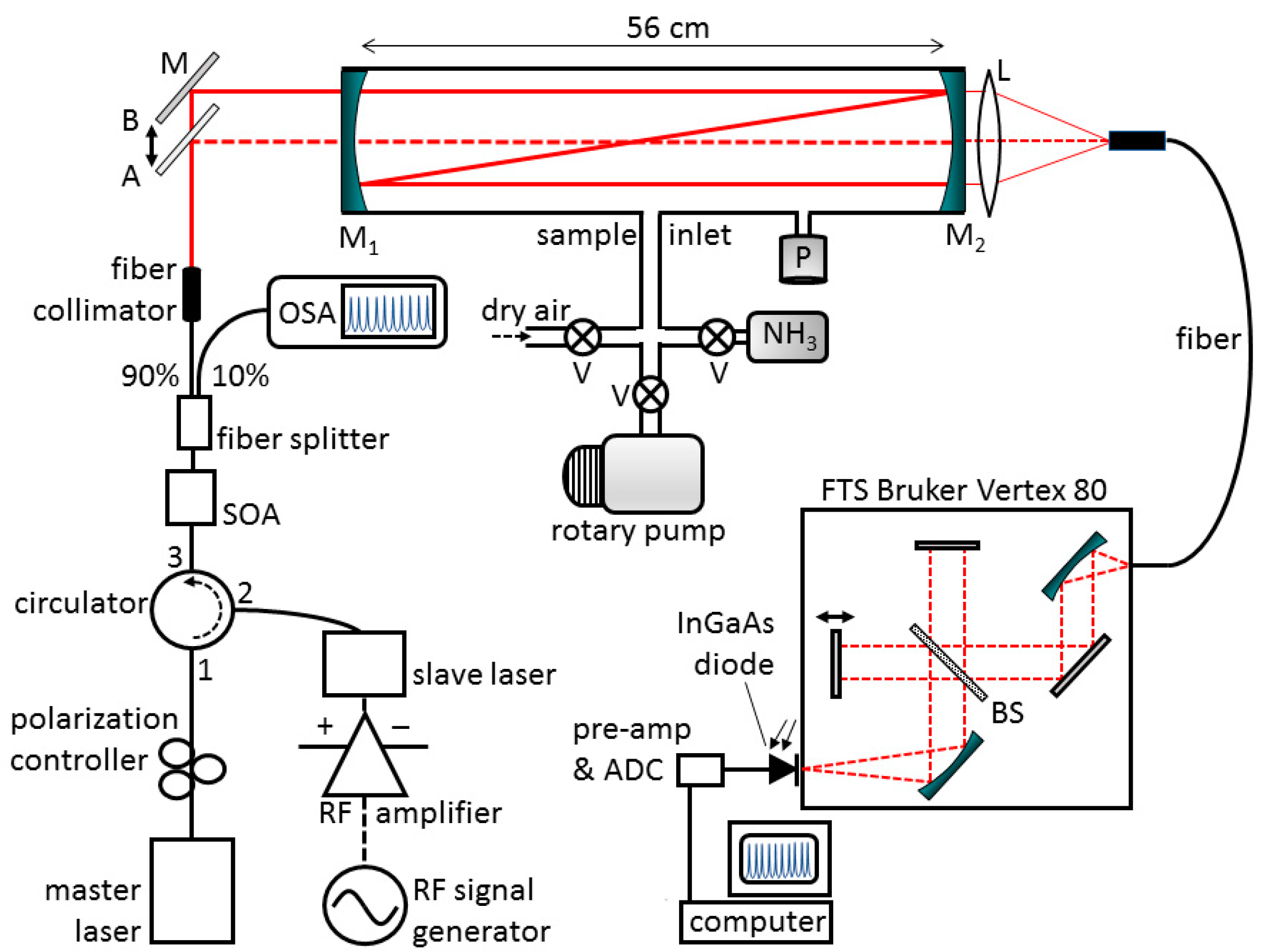
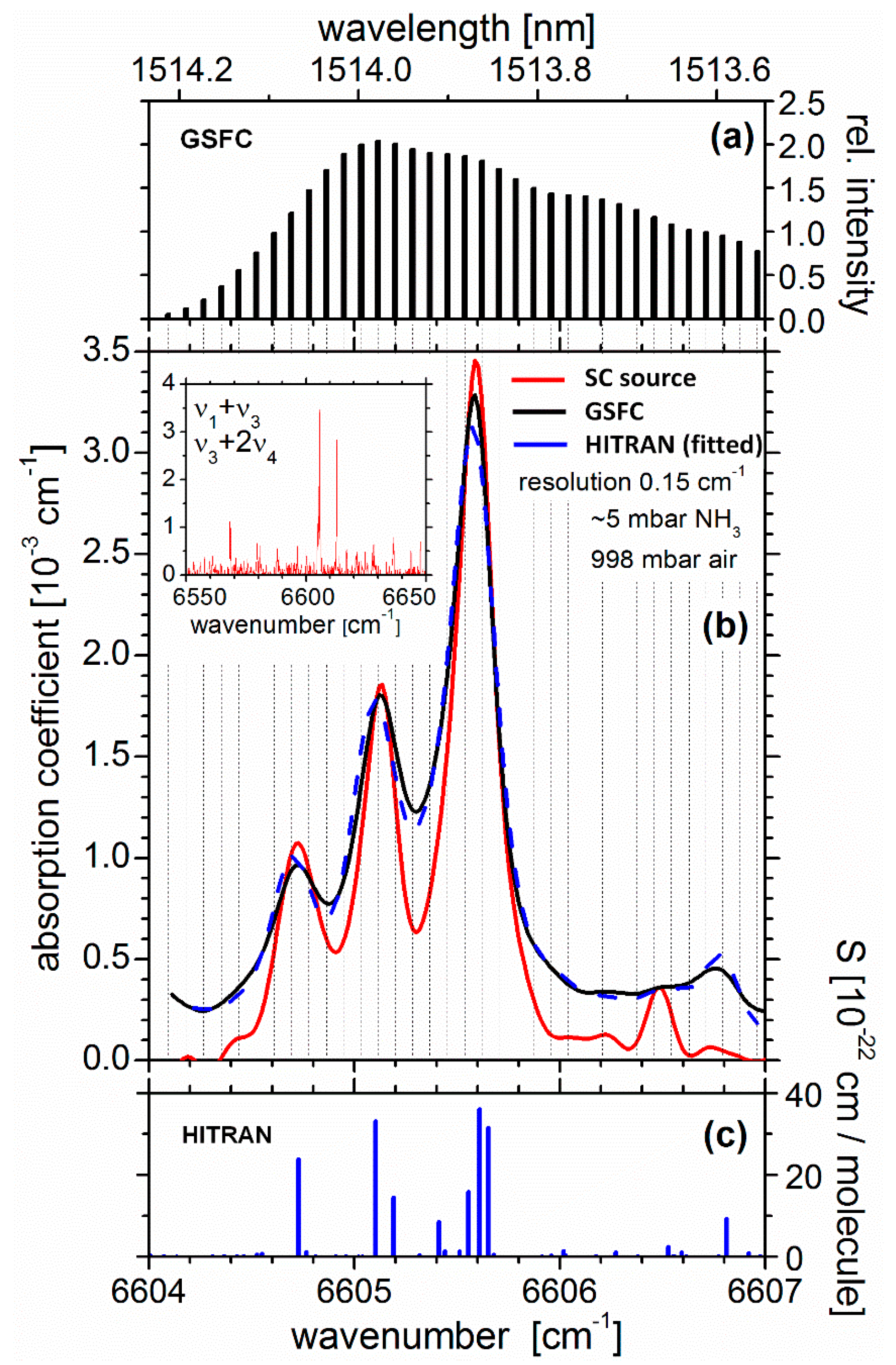
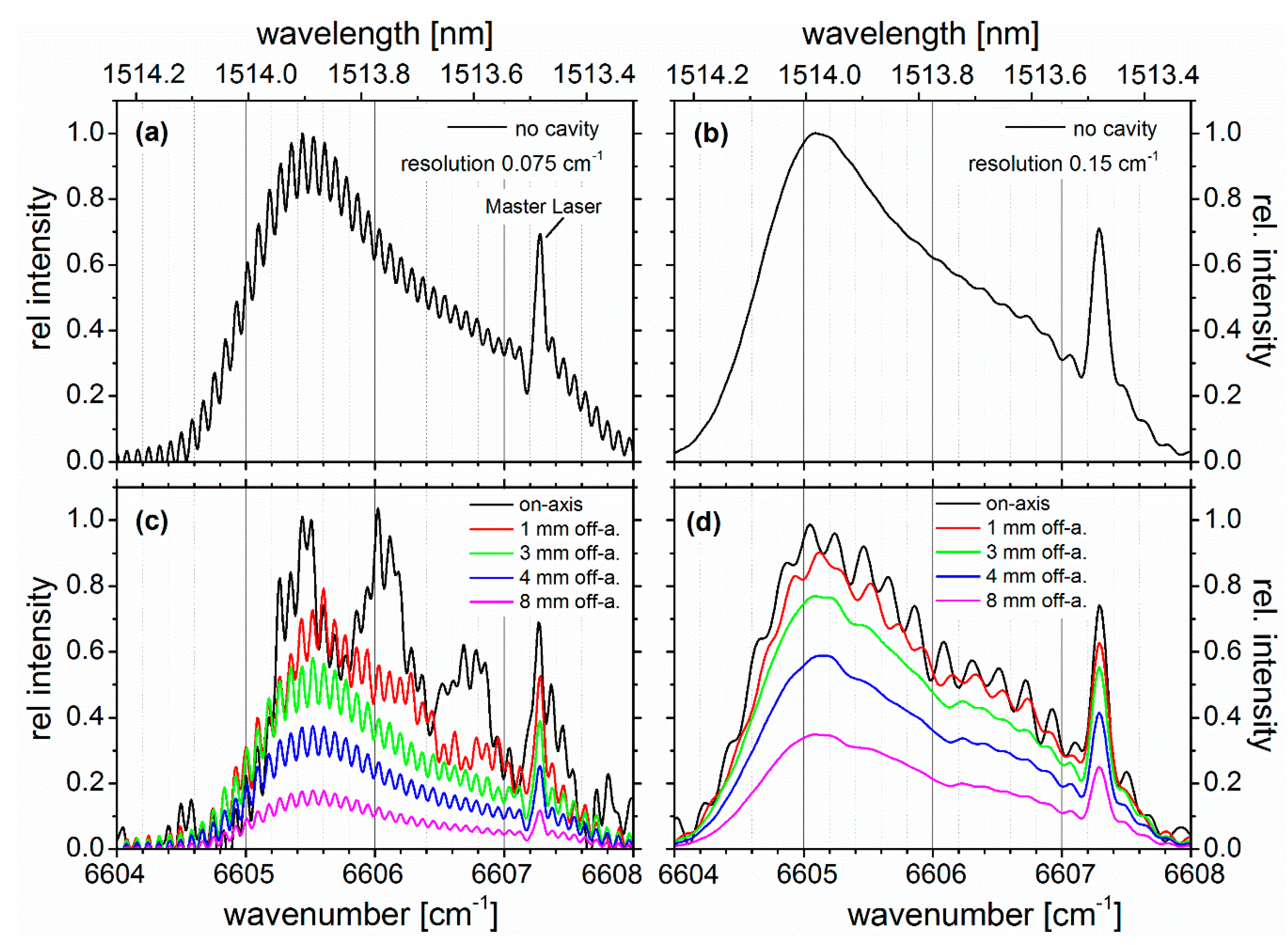
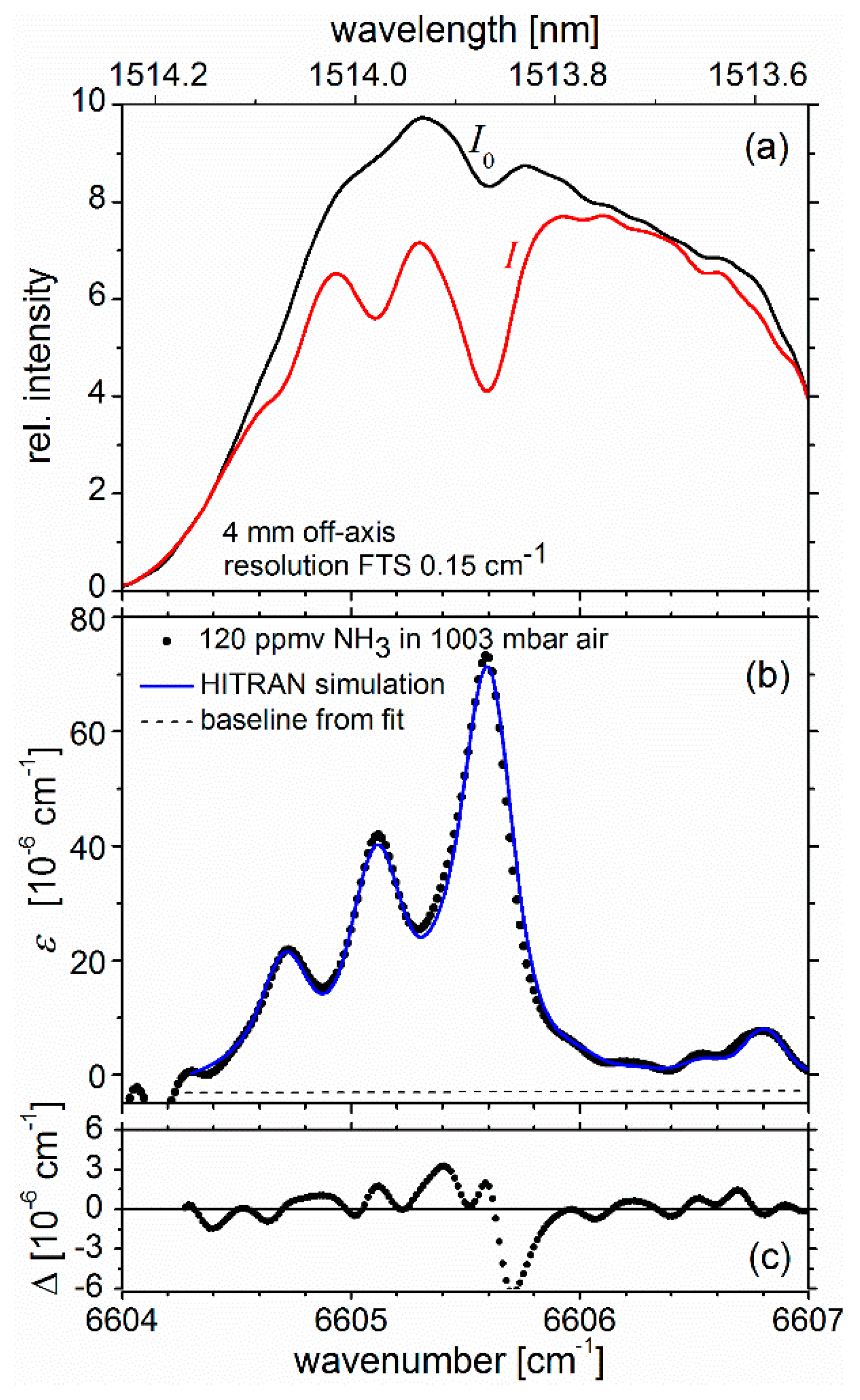
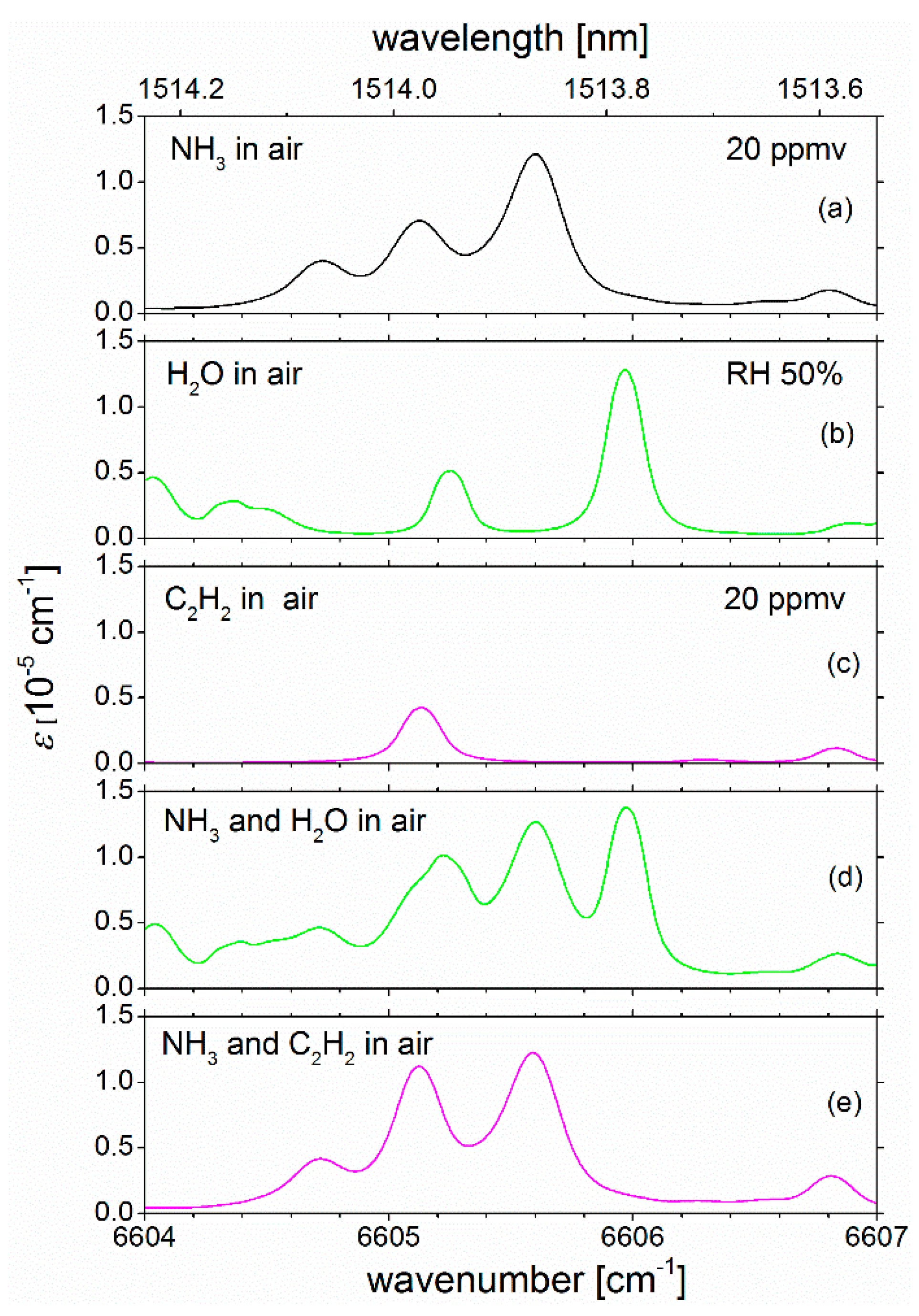
© 2019 by the authors. Licensee MDPI, Basel, Switzerland. This article is an open access article distributed under the terms and conditions of the Creative Commons Attribution (CC BY) license (http://creativecommons.org/licenses/by/4.0/).
Share and Cite
Chandran, S.; Ruth, A.A.; Martin, E.P.; Alexander, J.K.; Peters, F.H.; Anandarajah, P.M. Off-Axis Cavity-Enhanced Absorption Spectroscopy of 14NH3 in Air Using a Gain-Switched Frequency Comb at 1.514 μm. Sensors 2019, 19, 5217. https://doi.org/10.3390/s19235217
Chandran S, Ruth AA, Martin EP, Alexander JK, Peters FH, Anandarajah PM. Off-Axis Cavity-Enhanced Absorption Spectroscopy of 14NH3 in Air Using a Gain-Switched Frequency Comb at 1.514 μm. Sensors. 2019; 19(23):5217. https://doi.org/10.3390/s19235217
Chicago/Turabian StyleChandran, Satheesh, Albert A. Ruth, Eamonn P. Martin, Justin K. Alexander, Frank H. Peters, and Prince M. Anandarajah. 2019. "Off-Axis Cavity-Enhanced Absorption Spectroscopy of 14NH3 in Air Using a Gain-Switched Frequency Comb at 1.514 μm" Sensors 19, no. 23: 5217. https://doi.org/10.3390/s19235217
APA StyleChandran, S., Ruth, A. A., Martin, E. P., Alexander, J. K., Peters, F. H., & Anandarajah, P. M. (2019). Off-Axis Cavity-Enhanced Absorption Spectroscopy of 14NH3 in Air Using a Gain-Switched Frequency Comb at 1.514 μm. Sensors, 19(23), 5217. https://doi.org/10.3390/s19235217






